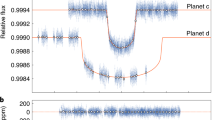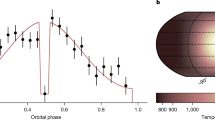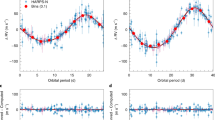Abstract
Hot Jupiters are a class of extrasolar planet that orbit their parent stars at very short distances. They are expected to be tidally locked, which can lead to a large temperature difference between their daysides and nightsides. Infrared observations of eclipsing systems have yielded dayside temperatures for a number of transiting planets1,2,3,4,5. The day–night contrast of the transiting extrasolar planet HD 189733b was ‘mapped’ using infrared observations6,7. It is expected that the contrast between the daysides and nightsides of hot Jupiters is much higher at visual wavelengths, shorter than that of the peak emission, and could be further enhanced by reflected stellar light. Here we report the analysis of optical photometric data8 obtained over 36 planetary orbits of the transiting hot Jupiter CoRoT-1b. The data are consistent with the nightside hemisphere of the planet being entirely black, with the dayside flux dominating the optical phase curve. This means that at optical wavelengths the planet’s phase variation is just as we see it for the interior planets in the Solar System. The data allow for only a small fraction of reflected light, corresponding to a geometric albedo of <0.20.
This is a preview of subscription content, access via your institution
Access options
Subscribe to this journal
Receive 51 print issues and online access
$199.00 per year
only $3.90 per issue
Buy this article
- Purchase on Springer Link
- Instant access to full article PDF
Prices may be subject to local taxes which are calculated during checkout


Similar content being viewed by others
References
Charbonneau, D. et al. Detection of thermal emission from an extrasolar planet. Astrophys. J. 626, 523–529 (2005)
Deming, D., Seager, S., Richardson, L. J. & Harrington, J. Infrared radiation from an extrasolar planet. Nature 434, 740–743 (2005)
Harrington, J., Luszcz, S., Seager, S., Deming, D. & Richardson, L. The hottest planet. Nature 447, 691–693 (2007)
Sing, D. K. & Lopez-Morales, M. Ground-based secondary eclipse detection of the very-hot Jupiter OGLE-TR-56b. Astron. Astrophys. 493, L31–L34 (2009)
de Mooij, E. J. W. & Snellen, I. A. G. Ground-based K-band detection of thermal emission from the exoplanet TrES-3b. Astron. Astrophys. 493, L35–L38 (2009)
Knutson, H. A. et al. A map of the day–night contrast of the extrasolar planet HD 189733b. Nature 447, 183–186 (2007)
Knutson, H. et al. Multiwavelength constraints on the day-night circulation patterns of HD 189733b. Astrophys. J. 690, 822–836 (2009)
Auvergne, M., Bodin, P., Boisnard, L., Buey, J., Chaintreuil, S. & CoRoT team The CoRoT satellite in flight: description and performance. Astron. Astrophys. (in the press); preprint at 〈http://arxiv.org/abs/0901.2206〉 (2009)
Barge, P. et al. Transiting exoplanets from the CoRoT space mission. I. CoRoT-Exo-1b: a low-density short-period planet around a G0V star. Astron. Astrophys. 482, L17–L20 (2008)
Samadi, R. et al. Extraction of the photometric information: corrections. Preprint at 〈http://arXiv.org/astro-ph/0703354〉 (2007)
Kurucz, R. ATLAS9 Stellar Atmosphere Programs and 2 km/s Grid. (Kurucz CD-ROM No. 13, Smithsonian Astrophysical Observatory, 1993)
Fortney, J., Lodders, K., Marley, M. & Freedman, R. A unified theory for the atmospheres of the hot and very hot Jupiters: two classes of irradiated atmospheres. Astrophys. J. 678, 1419–1435 (2008)
Cooper, C. & Showman, A. Dynamic meteorology at the photosphere of HD 209458b. Astrophys. J. 629, L45–L48 (2005)
Showman, A. et al. Atmospheric circulation of hot Jupiters: coupled radiative-dynamical general circulation model simulations of HD 189733b and HD 209458b. Astrophys. J. (submitted); preprint at 〈http://arXiv.org/abs/0809.2089〉 (2008)
Burrows, A., Hubeny, I., Budaj, J., Knutson, H. & Charbonneau, D. Theoretical spectral models of the planet HD 209458b with a thermal inversion and water emission bands. Astrophys. J. 668, L171–L174 (2007)
Grillmair, C. et al. Strong water absorption in the dayside emission spectrum of the planet HD 189733b. Nature 456, 767–769 (2008)
Knutson, H., Charbonneau, D., Burrows, A., O’Donovan, F. & Mandushev, G. Detection of a temperature inversion in the broadband infrared emission spectrum of TrES-4. Astrophys. J. 691, 866–874 (2009)
Cowan, N., Agol, E. & Charbonneau, D. Hot nights on extrasolar planets: mid-infrared phase variations of hot Jupiters. Mon. Not. R. Astron. Soc. 379, 641–646 (2007)
Knutson, H., Charbonneau, D. & Allen, L. The 3.6–8.0 μm broadband emission spectrum of HD 209458b: evidence for an atmospheric temperature inversion. Astrophys. J. 673, 526–531 (2008)
Harrington, J. et al. The phase-dependent infrared brightness of the extrasolar planet υ Andromedae b. Science 314, 623–626 (2006)
Burrows, A., Budaj, J. & Hubeny, I. Theoretical spectra and light curves of close-in extrasolar giant planets and comparison with data. Astrophys. J. 678, 1436–1457 (2008)
Collier Cameron, A., Horne, K., Penny, A. & Leigh, C. A search for starlight reflected from υ And’s innermost planet. Mon. Not. R. Astron. Soc. 330, 187–204 (2002)
Leigh, C. et al. A search for starlight reflected from HD 75289b. Mon. Not. R. Astron. Soc. 346, L16–L20 (2003)
Leigh, C., Collier Cameron, A., Horne, K., Penny, A. & James, D. A. new upper limit on the reflected starlight from τ Bootis b. Mon. Not. R. Astron. Soc. 344, 1271–1282 (2003)
Rowe, J. F. et al. The very low albedo of an extrasolar planet: MOST space-based photometry of HD 209458. Astrophys. J. 689, 1345–1353 (2008)
Cox, A. N. in Allen’s Astrophysical Quantities 4th edn (ed. Cox, A. N.) Ch. 1 (Athlone, 2000)
Seager, S., Whitney, B. A. & Sasselov, D. D. Photometric light curves and polarization of close-in extrasolar giant planets. Astrophys. J. 540, 504–520 (2000)
Green, D., Matthews, J., Seager, S. & Kuschnig, R. Scattered light from close-in extrasolar planets: prospects of detection with the MOST satellite. Astrophys. J. 597, 590–601 (2003)
Hood, B., Wood, K., Seager, S. & Collier Cameron, A. Reflected light from three dimensional exoplanetary atmospheres and simulations of HD 209458b. Mon. Not. R. Astron. Soc. 389, 257–269 (2008)
Acknowledgements
We thank the CoRoT team for making the CoRoT data, which forms the basis of this study, publicly available in a high-quality and comprehensible way. The CoRoT space mission, launched on 27 December 2006, was developed and is operated by the Centre National D’Études Spatial, with participation of the science programmes of the European Space Agency, the European Space Research and Technology Centre and the Research and Scientific Support Department, Austria, Belgium, Brazil, Germany and Spain. We thank R. Le Poole for discussions.
Author information
Authors and Affiliations
Corresponding author
Supplementary information
Supplementary Information
This file contains Supplementary Methods and Data, Supplementary References Supplementary Table 1and Supplementary Figures 1-11 with Legends. (PDF 522 kb)
PowerPoint slides
Rights and permissions
About this article
Cite this article
Snellen, I., de Mooij, E. & Albrecht, S. The changing phases of extrasolar planet CoRoT-1b. Nature 459, 543–545 (2009). https://doi.org/10.1038/nature08045
Received:
Accepted:
Issue Date:
DOI: https://doi.org/10.1038/nature08045
This article is cited by
-
Variability in the atmosphere of the hot giant planet HAT-P-7 b
Nature Astronomy (2016)
-
The EChO science case
Experimental Astronomy (2015)
Comments
By submitting a comment you agree to abide by our Terms and Community Guidelines. If you find something abusive or that does not comply with our terms or guidelines please flag it as inappropriate.



